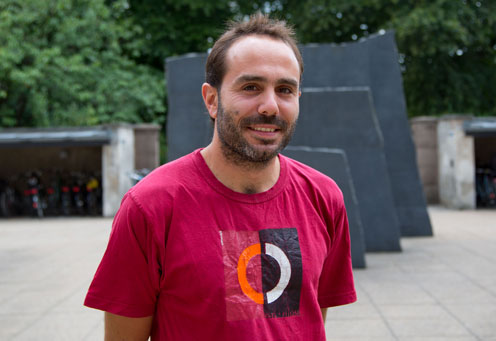Giorgos Leloudas receives 10 million DKK to investigate the “blackest” of black holes in the Universe
The research in black holes in the center of galaxies gets a boost on 10 million DKK with a Villum Young Investigator grant to assistant professor Giorgos Leloudas at DARK Cosmology Centre, Niels Bohr Institute at the University of Copenhagen. This type of black holes are the most abundant in the Universe, but they are difficult to gain knowledge about, as they are only visible under special circumstances.

Assistant professor Giorgos Leloudas at DARK Cosmology Centre gets a boost on 10 million DKK with a Villum Young Investigator grant to research in the black holes.
How do you see the “blackest” of black?
At the center of every galaxy in the Universe there is a black hole (a galactic nucleus): An object with a gravity so strong that not even light escapes it. This means a paradox must be overcome when one wants to study it, because it is invisible. Something extraordinary must take place if a black hole is to emerge from its darkness, and some galactic nuclei are interacting with their immediate surroundings, e.g. in the form of gas clouds being drawn into the hole by its immense gravity, where they warm up and emit light. But the vast majority of black holes or galactic nuclei do not have this interaction, and are consequently invisible. It is this type that interests Giorgos Leloudas the most. His project is about finding transient events in the galactic nuclei. One such event could be a star being drawn into a black hole. It is torn apart by the gravity and we are able to, for a short period of time, to see the light emission. This gives us access to study the otherwise completely dark, black holes and learn about an object we would otherwise have no access to study what so ever. Giorgos calls these galactic nuclei “the silent majority”, because they are the most abundant of their kind in the Universe.
A new scientific field
The project bears the name STING (Studying Transients In the Nuclei of Galaxies). It is actually about studying all types of transient events in galactic nuclei, in order to answer fundamental questions about the physics of black holes and the development of galaxies. It is an area that hasn’t been given too much attention before. We are only beginning to develop a categorization of the many different types of events that take place in galactic nuclei. The more ways we observe the Universe, the more differentiated our view is, the more potential objects of interest pop up. Giorgos Leloudas’ project is part of the greater body of work with these exciting, new discoveries.
International collaboration is key
Today app. 10.000 transients are found annually. App. 30 % are in the vicinity of galactic nuclei. Only around 1000 are observed with a spectrograph, where the light spectrum is divided into wavelengths, and this is necessary for Giorgos’ work. “I try to get as many spectra as I can from the European, scientific collaboration called ePESSTO. I am PI (Principal Investigator) in this field, which we call “Tidal Disruption Events”, says Giorgos. Only when we have access to observations with spectrograph, can we examine the many different events we can see, can we categorize them correctly and thus find the real, interesting transient events to study.
The plans for the new grant
More manpower is needed, that’s for sure. Giorgos Leloudas is planning to hire a postdoc and a Ph.D. student by using the Villum grant. More hands and eyes are needed for the examination of data. A large part of the task is to “filter” the data available, in order to find the right transients to study. In this way, the grant will contribute to the buildup of the scientific community, centered in the DARK Cosmology Centre at the Niels Bohr Institute, where the actual work will take place.

Giorgos Leloudas, assistant professor, DARK Cosmology Centre, Juliane Maries Vej 30, 2100 København Ø, Rockefeller, Email: giorgos@nbi.ku.dk Phone: +45 35 32 03 37
Topics
see
Contact
Giorgos Leloudas, assistant professor, DARK Cosmology Centre, Juliane Maries Vej 30, 2100 København Ø, Rockefeller, Email: giorgos@nbi.ku.dk Phone: +45 35 32 03 37
